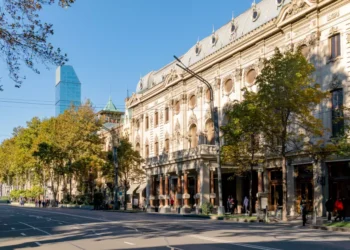The conventional wisdom that death equalizes everybody doesn’t seem to be true in Sakartvelo. Following the inevitable demise, some of us are interred in regular cemeteries, while others are destined to find their final abode in a special place called a pantheon – a necropolis, or a burial place for certain preeminent sons and daughters of the nation.
The Tbilisi Pantheon of Public Figures, headed by its director Otar Chachanidze, is an association comprising four pantheons: Mtatsminda Pantheon, Didube Pantheon, the New Pantheon at Mount Makhata, and Khojavank Pantheon of Armenian Public Figures.
There is also a separate pantheon for prominent Azerbaijanis, located in the National Botanical Garden of Georgia, and not to overlook, the Saburtalo Pantheon. The pantheons operate under the capital city administration, which decides who deserves to be buried where. Among these pantheons, the most prestigious is the Mtatsminda (Holy Mountain) Pantheon, the sepulture of the most celebrated Georgian writers, artists, and public figures. The Mtatsminda Pantheon was inaugurated in 1929 to become a resting place for many prominent Georgians, with some of the graves relocated there from other graveyards.
Today, the Mtatsminda Pantheon is a place of great cultural and historical importance, containing the graves of national biggies like Ilia Chavchavadze and Vazha-Pshavela. The eminent Russian poet, the spouse of the Georgian Princess Nino Chavchavadze, is also buried there. Visitors can reach the Mtatsminda Pantheon by taking the cableway or funicular, or by walking down a path from the upper park. By the way, there are pantheons in Batumi and Kutaisi too.
Last Sunday afternoon, a wonderful event took place in one of the most beautiful corners of the Mtatsminda Pantheon, overlooking the gorgeous landscape of Old Tbilisi. At the initiative of Otar Chachanidze, a new project was created, titled The Pantheon Chronicles. It was the day of the project’s inauguration and the moment of introducing its first episode – the documentary about one of Georgia’s recognized geniuses, Vazha-Pshavela, created by the ATINATI noncommercial charity foundation as part of a series called Georgia’s Heroes. The organization was represented by Manana Bakradze, a theatrical director by profession, who made a laconic introductory speech to elucidate what was going on.
Among the invited guests was one of the descendants of the poet, journalist Lela Razikashvili, the chairperson of the Vazha-Pshavela Foundation, who spoke briefly but very emotionally and meaningfully about her great predecessor’s life and work. The event was monitored by Badri Kutateladze, the well-known public figure, poet, author of numerous popular editions, and the director of the Didube Pantheon.
Incidentally, Kutateladze has recently published his encyclopedic opus, comprising the biographies of 650 Georgian public figures, poets, belletrists, artists, and sculptors, whose resting place is the Didube Pantheon. Otar Chachanidze emphasized that within the framework of his new project, they will continue presenting documentaries about other prominent people of the country. On top of everything, besides the general public, representatives of various fields will be invited to participate in upcoming events to give interesting talks about Georgian culture and history.
The Mtatsminda Pantheon is now closed to new entombments, but it is certainly open to the public. The Didube Pantheon can hardly continue interments due to a lack of space. Meanwhile, the tradition of maintaining pantheons, which began in Sakartvelo in the late 1880s and early 1890s, continues to thrive. This is why new pantheons are being introduced, and they cost the city a lot.
In a word, the tendency to discriminate after death is sadly in place, but at the same time, it’s probably a good thing that our public has a chance to pay homage to their favorite public figures, actors and actresses, men and women of pen and brush, sculptors, musicians, and all those who, in their own time, earned the nation’s love and regard. One might think that there is an exaggerated national ambitiousness
in a tradition like this one, but hey, isn’t the Arlington Cemetery in the vicinity of Washington D.C. doing the same kind of job?! The whole thing might be taken as one of the expressions of human will and freedom, and, if you wish, a stimulus to try to be good enough in life to posthumously deserve a spot in a prestigious place like a pantheon. LOL!
Blog by Nugzar B. Ruhadze














